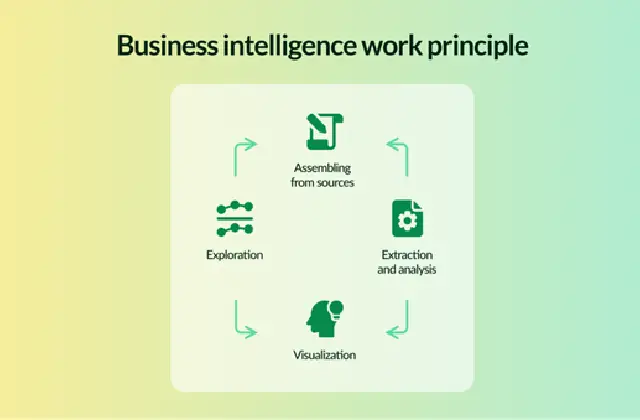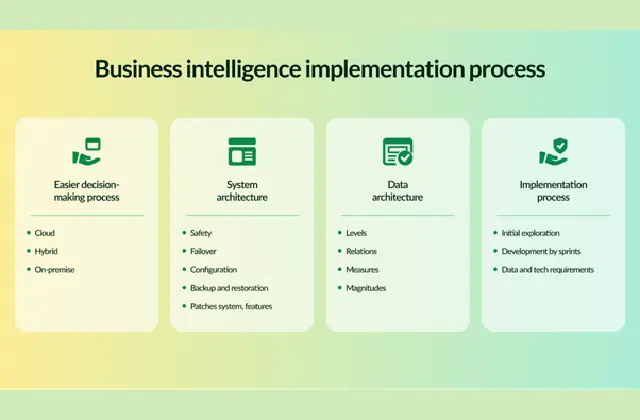Regardless of your business’s direction, you must work with vast information. This can include customer data, sales data, charts, etc. In such an array of data, it is easy to lose sight of something. Competent business intelligence (BI) will help to avoid such a mistake. Today we will discuss how to implement this tool in your business and what benefits it will bring.
Business Intelligence Concept
Let’s start with a definition of the term Business Intelligence (BI). BI is a system that allows you to collect and process a large amount of data. Thanks to this, you will have the opportunity to work out the company’s development plan in more detail, learn more about users and improve business performance in general.
BI elements include text mining, data collection and processing, statistical analysis, and others. However, these elements are included in the implementation process. BI uses several methods to collect data, including the following:
- Data extraction (ETL) is the process of collecting data from multiple sources, after which it begins to be transformed and loaded into a data storage system.
- Online transactional processing (OLTP) is a data collection method that allows you to track various user transactions online.
- Social media and web data collection is a method that allows you to collect information from social networks or other popular Internet resources. Thanks to it, you can quickly “catch” trends and adapt to changes.
- Collaborative BI is one of the simplest ways to collect information, the user shares they opinion, which the system processes and uploads to the database.
These are just a few examples of the most popular methods used by BI systems. We also note that often working with databases requires large capacities, but some systems facilitate the work. For example, with the help of Embedded BI, all indicators can be transferred to the framework of a mobile application, allowing you to reduce data processing time and simplify decision-making.
We can describe the systems for a long time, let’s move on to the more practical part!

Why Use Business Intelligence
It is not necessary to use BI, you can use the work of the marketing department, look at the rise or fall of (for example) a mobile application. But decisions made in a few weeks may be too late. This will not happen because of the inefficient work of someone from your team but simply because of limited information or the inability to process it quickly. Business Intelligence guarantees fast monitoring of simple indicators (and likely trends) and possible directions. Let’s discuss this in more detail.
Better Decision Making
You can get a broad picture of the company’s state of affairs using BI. Accurate graphs and indicators make it much easier to make the right decision.
Definition of risk
Every business involves some risk, and blindly following your instincts is unreliable. However, the more you know about the current market situation, the better you can calculate your chances and make informed decisions.
Effective budget management
By receiving data on your business’s success and the audience’s specifics, it will be easier to determine profitable development directions and distribute the budget more efficiently.
Now that we’ve discussed the benefits let’s delve into the technical details!
Business Intelligence Implementation Process
We will divide the process of implementing BI in your business into several steps and consider them separately!
Step 1. Planning
The implementation of all ideas begins with a plan. Before you implement business intelligence systems, describe in detail the goals you want to achieve. Naturally, you can take indicators of everything and make decisions. But developing such a system will cost you a lot of money, which may not be a profitable investment initially. By goals, we mean:
- Increasing profit
- Improve user experience
- Definition of promising directions
The next element is to pay attention to KPIs (Key Performance Indicators). They should correspond to your goals formulated earlier. Here are questions that you can answer to develop your own KPIs:
- What data resource do you need?
- What type of data is necessary for analysis?
- Who should have access to the data?
- In what form do you want to receive data?
- How do you want to measure progress?
Also, remember – it is desirable to embed BI at the very beginning of development and not in the middle or end.
Step 2. Prepare the solution for infrastructure development
Since the data needs to be stored somewhere, you must create a data store. This is one of the most essential elements of the infrastructure since it is in it that information will be accumulated, which, with the help of BI, will be transformed into infographics and other indicators.
You have several storage options:
- On-Premise
- Cloud
- Hybrid
If your choice falls on cloud-based software development, then after establishing the structure, you will need to choose a BI provider.
Step 3. Choose BI Software for your business
The choice of a business intelligence system should be approached carefully. Developing each software costs a lot of money, and if it does not bring any benefit, severe financial problems are potential. To avoid them, follow the method described above – detail the tasks. Then, if everything is done correctly, the development process will not be delayed, and the funds invested will quickly pay off.
After determining everything you need, you should move on to developing features. But, again, the situation is the same: identify the most necessary and integrate them.
Step 4. Business intelligence implementation
If you followed all the previous steps correctly, this should be fine. However, BI implementation will take a long time. So this process can be divided into 3 stages:
- Data processing. This must be done to transform all the necessary information in the format of BI systems.
- Add functionality and make adjustments. During business intelligence implementation, you must constantly look at the performance of all systems – this will avoid errors or prevent the development of unnecessary software.
- Team training. You need to be able to work with BI, adapting to the new is always tricky. Therefore, discuss all the points with the team and introduce , for example, courses.
Step 5. Working with BI
The final stage is simply working with the system. At this point, you’ve l already received all the necessary data and developed your business in the direction you need.
Now let’s move on to an equally important point, namely the price.
BI Implementation Cost
Before you start looking for software development companies, get acquainted with the pricing policy on the market in more detail. So, on average, the price for implementing business intelligence varies from $140,000 – $200,000. But these numbers are average, the price in your case may be different. The price factor is influenced by the following:
- Data volume
- Analytics type, number of machine learning algorithms
- Number of indicators
- Using Big Data Analytics.
The development team also affects the price. The size of the technical partner’s company and its geolocation can reduce the creation cost or make this process more expensive.
But remember, when implementing such large-scale and complex ideas, contact only with professional teams. Incorrect system settings can literally bankrupt your business.
Author’s bio: Yuliya Melnik is a technical writer at Cleveroad. It is a web and mobile app development company in Ukraine. She is passionate about innovative technologies that make the world a better place and loves creating content that evokes vivid emotions.
Related
